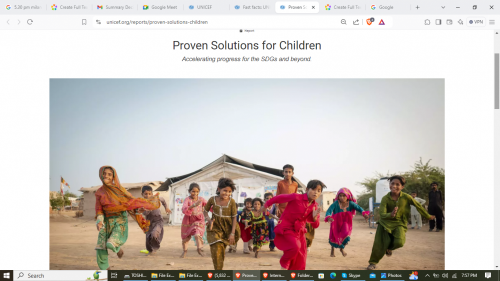
https://www.unicef.org/press-releases/fast-facts-unicef-highlights-four-...
https://www.unicef.org/reports/proven-solutions-children
NEW YORK, 23 September 2024 – Government leaders, high-level guests and UN Representatives joined UNICEF, the African Union and the European Union for a high-level dialogue on proven policy solutions for children on the sidelines of the 79th UN General Assembly.
At the event, UNICEF released Proven Solutions for Children, which examines four evidence-based and cost-effective priority policy solutions aimed at accelerating progress toward the UN Sustainable Development Goals.
“We must significantly accelerate progress on the 2030 Agenda by implementing cost-effective, evidence-based policy solutions that can be rolled out across countries regardless of income,” said UNICEF Executive Director Catherine Russell. “It is imperative that we ramp up actions, and investments, to strengthen systems that children rely on, like health care, social protection, nutrition services, education, water and sanitation.”
Facts on the four key policy areas:
Child nutrition and development in the early years
- Globally, one in five children under five years of age – or 148 million – suffer from stunting (chronic undernutrition); 29 per cent of children aged 3–5 years are not developmentally on track; and 136 million children aged 5–10 years suffer from overweight and obesity.
- Stunting has declined by 45 per cent in the last three decades and the number of children with stunted growth and development due to malnutrition in early childhood has been reduced by 110 million in that period.
- If countries meet the global target of ensuring 50 per cent of infants are exclusively breastfed by 2025, over US$300 billion will be generated due to improved child survival, nutrition, and cognitive development. Every dollar invested in promoting and supporting breastfeeding generates a return of $35 in economic benefits.
Immunization
- In the last 50 years, immunization has saved the lives of 146 million children under five years of age, contributing to a 40 per cent global reduction in infant mortality. Global access to vaccinations expanded from 20 per cent coverage in 1974, to 85 per cent in 2023.
- If countries achieve the SDG 2030 target of 90 per cent coverage for key vaccines, around 51 million deaths would be averted between 2021–2030.
- Beyond child survival, the human, financial and social returns of investing in immunization are far-reaching. On average, every dollar invested in immunization generates a return of $21 in economic benefits.
Secondary education for adolescent girls
- 119 million girls, many of whom are adolescents, are out of school worldwide.
- Nearly 1 in 4 girls aged 15–19 globally is not in education, employment or training compared to 1 in 10 boys.
- Less than US$2 per day invested in a girls’ secondary education can yield a return of up to 10 per cent in a country’s economic growth.
Social protection and universal benefits for children
- Nearly 1 billion children live in multidimensional poverty. More than 300 million children live in extremely poor households, surviving on less than US$2.15 per person per day.
- Out of the total global social protection expenditure, only 3.8 per cent is spent on children, and nearly 1.8 billion children under the age of 18 do not have access to social protection or child benefits.
- While the prevalence of poverty is due to multiple factors, countries without child cash benefits report higher poverty rates, on average, than those with child cash benefits. The average poverty rate across countries that don't have child cash benefits is 33.5 per cent, while in countries that do have child benefits, poverty rates are lower on average at 14.2 per cent.









